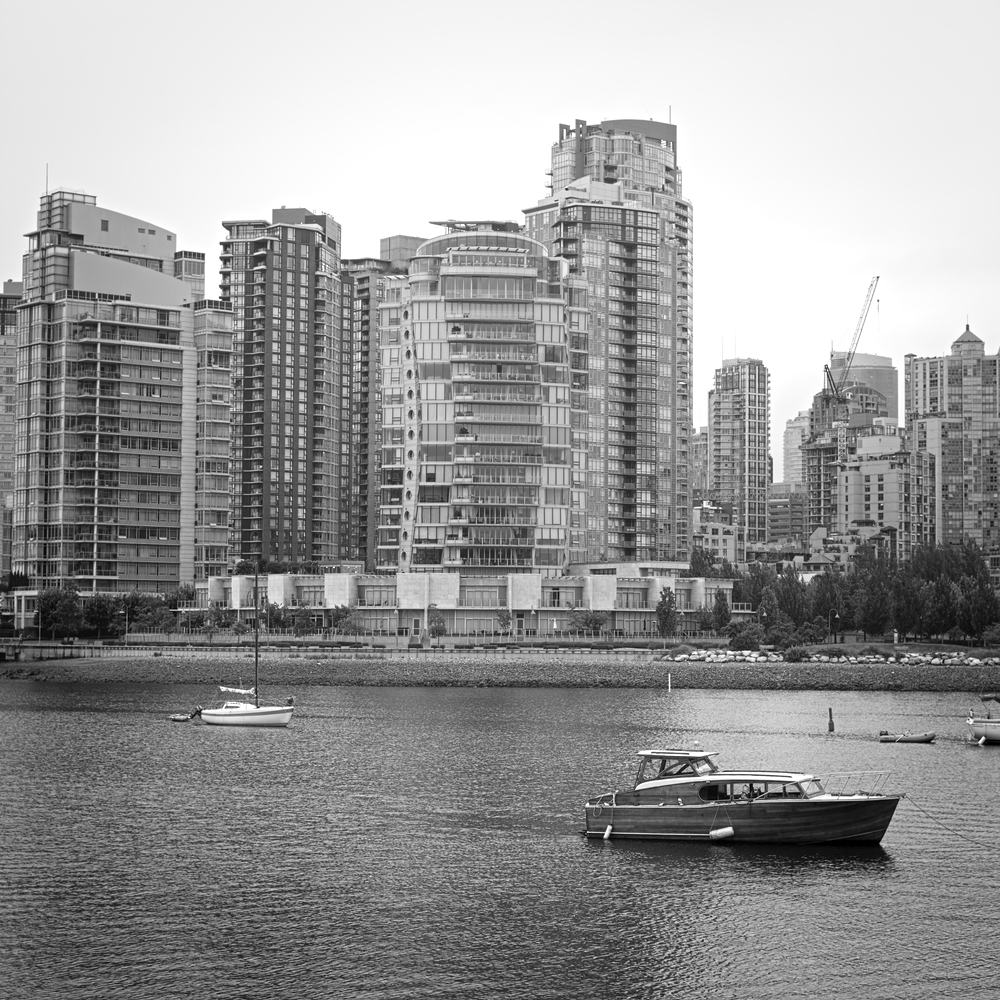The Salish Sojourn XIII
Vancouver, British Columbia

Highrise towers line the waterfront in Vancouver, BC
Vancouver is the last stop on our Salish Sojourn. It is a bit of a homecoming, as we lived for two years in Vancouver, but that was seventeen years ago. I've grown older and grayer; I suspect the city has as well.
I still find it rather remarkable that the only way to get to Powell River with a car is by ferry. There are no overland routes marked on the map. I don't know why I find this so amazing: you must take a ferry to get to Vancouver Island as well, and that didn't impress me a bit. In any event, we leave Powell River in the morning, drive south on the Sunshine Coast Highway, until it simply terminates at the ferry terminal in Saltery Bay. We drive aboard, sail south, and then disembark at Earl's Cove. Now the fun can begin: an entire ferry-load of cars and trucks blasts south on the Sunshine Coast Highway, a winding two lane road. Speed up, slow down, Winnebagos ahead, log trucks on my bumper. Eighty kilometers and twelve grey hairs later, we reach Grantham's Cove, where once again the "highway" ends in a ferry terminal. Load up on a second ferry and we continue on to Horseshoe Bay, Vancouver's northern ferry port.
Afternoon rush hour traffic in Vancouver is no worse than I remember. It still baffles me that a major world city has a four lane highway as its principal arterial, but there it is. The thinking seems to be that if the traffic flows slowly, people will get frustrated and take public transport.
Hmm…

Control Room, TRIUMF Facility, Vancouver, BC
We are staying in campus housing on the University of British Columbia. Our domicile, the TRIUMF House, hosts visiting nuclear scientists. We have secured a space there, despite the fact that neither of us know anything about atomics. It is a pleasant, one room accommodation, and despite the notoriously high property prices in Vancouver, one of the cheapest places we've stayed.
TRIUMF is Canada's national laboratory for particle and nuclear physics. They operate the world's largest cyclotron, a massive device that accelerates protons to three-quarters of the speed of light. Also, they have a free tour in the afternoon. Since we are staying in their house, it would seem churlish not to visit their facility. Which is how we come to find ourselves strolling into the visitor's center on a sunny afternoon.

Mysterious experiment, TRIUMF Facility, Vancouver, BC
Even after taking the tour, I find myself unable to explain what a cyclotron does. The basic concept, as I understand it, is that a system of electromagnets are used to accelerate protons to an incredible velocity: three-quarters the speed of light. Once they have reached speed, these protons are then fired down a beam, guided by more electromagnets, at targets.
The targets could be other elements, which can be turned into substances like the radionucleides used in medicine to scan for diseases. The beam can also be used to blast tumors behind the eyes, destroying malignant cells.

Another mysterious device, TRIUMF Facility, Vancouver, BC
As we walked through large hangars hosting a variety of experiments, the explanations became more esoteric, and it left my head spinning. The common theme was disorder: pipes, stainless steel, wiring, and computerized instrumentation cluttered the spaces around the experiments. I don't know how the protons managed to find their way to the right places.
The final demonstration was found back in the visitor's center. After being scanned to ensure that we hadn't picked up any radiation along the way, we gathered around a device that resembled the pensieve in the Harry Potter movies. It was a cloud chamber. As we watched, ghostly trails materialized, shooting and curling like meteors across the surface of the device. These trails of light were made by the background radiation that is constantly flying all around us. It was a mesmerizing display, although a bit disconcerting to realize how many of these particles are lancing through our bodies every moment.
The TRIUMF tour was fascinating, an excellent way to spend an afternoon in Vancouver.
If you are enjoying this series, why not subscribe to Richard's monthly newsletter, What's New in Old News? The Peripatetic Historian is on the road, roaming the world and compiling fresh adventures. Don't miss out. Click here to join the legions of above-average readers who have already subscribed.